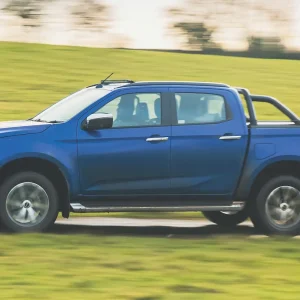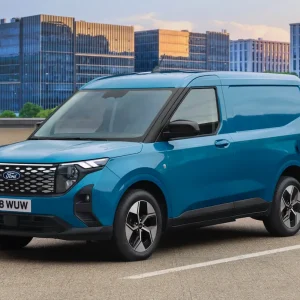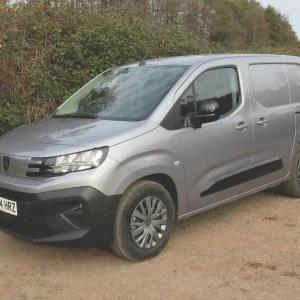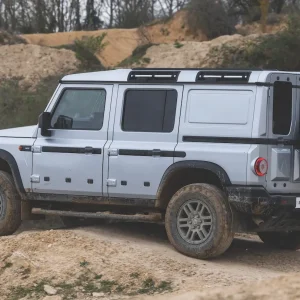What do the United Kingdom, the Republic of Ireland, Malta, and Cyprus all have in common? They are all right-hand drive markets, which means none of them are currently benefiting from the Open Sesame door available as an option on the latest Renault Kangoo in left-hand drive countries.
That must be counted as a disappointment because the door allows the entire side of the van to be opened up for ease of loading and unloading. Eliminating the B-pillar, it is one of the few genuine innovations in the structural design of light commercials to appear in recent years.
Renault’s British operation is pushing hard for Open Sesame to be rolled out on this side of the Channel. We can only hope it succeeds.
In the meantime the most recent iteration of the Kangoo has plenty of other things going for it.
Winning the What Van? Compact Van of the Year Award for 2023, it boasts a revamped cab interior, a restyled exterior with C-shaped LED daytime running lights and a host of driver assistance features. Unfortunately rather too many of them are optional rather than standard, adding to the vehicle’s overall price should you want them.
The improvements made to the electric model represent perhaps the most significant changes, given the steady swing in favour of zero-emission vehicles.
The old battery-electric Kangoo came with a 33kWh battery delivering a claimed maximum range of 143 miles between recharges, and a 44.7kW (60hp) motor. Its E-Tech successor boasts a 45kWh battery, a claimed range of 186 miles, and an 89kW (121hp) motor.
A full recharge can be completed in just over six hours using a 7.4kW wall box, while 80% of the battery’s capacity can be replenished in just over 40 minutes using a 75kW DC rapid charger, says Renault. Recharging from 15% to 80% using a 22kW public charger takes 1.5 hours, the manufacturer adds.
Customers wedded to more traditional propulsion technologies can opt for a 1.5-litre Blue dCi diesel at either 95hp or 115hp. The latter is available solely with the optional seven-speed automatic EDC transmission.
The 1.3-litre 100hp TCe petrol engine may prove popular among businesses on short-haul local work that are horrified by the price of diesel, but as yet do not want to go electric.
A six-speed manual gearbox is standard across the diesel/petrol line-up apart from on the 115hp variant.
Kangoo customers can opt for either a short or long wheelbase model with load cubes of 3.3m3 and 4.2m3 respectively, and choose from two specification levels; Start, or the more upmarket Advance. Mention should also be made of the availability of a crew van.
We got to grips with a short-wheelbase 95hp diesel ML19 Blue dCi 95 van in Start trim. Here’s how we fared.

Load bay
Access to the cargo area is by means of asymmetric rear doors – the narrower of the two is on the offside – and a sliding door on each side of the body. The back doors can be swung through 90°, and through 180° if you release the stays.
There are ten load tie-down points along with a full-height plastic bulkhead. It bulges backwards and intrudes into the side door apertures as a result.
It looks substantial enough, and offers a weight saving, but as traditionalists, we prefer the protection afforded by a steel partition.
A 12V socket is a handy feature, and one likely to be appreciated by trades people who use power tools.
Our demonstrator’s load floor was protected by a tailored rubber mat and the sides and doors were largely defended against minor damage by a selection of plastic panels. The mat and panels are optional.
Our Kangoo was equipped with an optional Easy Inside Rack load area ladder rack mounted beneath the roof. It takes up cargo space when in use, but some businesses may take the view that it makes more sense than mounting a rack on the roof.
Go the latter route and there is always the risk that your ladder will be stolen. Nor does it do much for the van’s aerodynamics, which means that fuel consumption will be adversely affected.
Rooftop bar fixings are provided, however, for those who still prefer a traditional ladder rack and do not want to lose load area room.

Interior and equipment
Good to see that chunky, user-friendly, switches control the heating and ventilation system and the manual air-conditioning. There are few things more annoying than having to fiddle about with a touchscreen when all you want to do is turn the fan speed up a notch.
Bear in mind that the optional Easylink 8in touchscreen, which looks for all the world as though it has been stuck on as a bit of an afterthought, controls pretty much everything else; so spend a bit of time getting to grips with it before you set off down the road. When we say ‘everything else’ that includes the optional satellite navigation system, Apple CarPlay, Android Auto and the standard DAB radio, although a steering column stalk plays host to remote controls for the latter.
Bluetooth connectivity is included in the Start deal and the dashboard plays host to a 12V power socket and USB ports.
Other kit includes a driver’s airbag, electric windows, heated and electrically-adjustable exterior mirrors, and cruise control with a speed limiter. The intensity of the instrument panel lighting can be adjusted.
Storage facilities include a large, deep, bin between the front seats, bins in each of the doors and a lidded, but not lockable, glove box.
A lidded compartment is positioned just above the instrument panel, a shelf sits on top of the fascia while another shelf sits above the windscreen on the driver’s side. A third one sits at the bottom of the dashboard, just in front of a couple of cup holders.
The aforementioned ladder rack extends into the upper part of the cab. It is boxed in, but the fact that it is so intrusive makes the cab feel a little claustrophobic.
The steering column and the driver’s seat are both height-adjustable.
The headlights illuminate automatically when it gets dark while rain automatically triggers the windscreen wipers. Other standard safety systems include ABS with Emergency Brake Assist, Electronic Stability Control and Hill Start Assist.
Traction Control is fitted too and can be switched off.
Our test vehicle was fitted with a variety of additional safety devices, but they were all
extra-cost options. The line-up included Active Emergency Braking System, Blind Spot Intervention, Advanced Lane Keep Assist, Tyre Pressure Monitoring System and 360° parking sensors complemented by a rear-view camera.
Disc brakes are fitted at the front and drums at the back. Specify an electric parking brake, and you get discs all round.
Our demonstrator’s non-standard 15in steel wheels were shod with Continental Eco Contact 6 195/65 R15 tyres. Kangoo usually sits on 16in wheels with 205/60 R16 tyres, and we can only assume that supply shortages obliged Renault to deviate from the norm.

Powertrain
Kangoo’s four-cylinder eight-valve common rail Euro 6D diesel delivers
its maximum power output at 3,750rpm. Top torque of 260Nm kicks in at 1,750rpm.
AdBlue held in an 18.6-litre reservoir helps keep exhaust emissions under control.
Driving
We’re suckers for a smooth manual gear change, and we weren’t disappointed. Kangoo delivers in spades in this department and the quality of the cog-swapping allowed us to get the best out of the engine.
It too delivers, with ample acceleration from rest, good mid-range performance enabling the Renault to sit happily on the M5 at the maximum permitted motorway cruising speed. The van handles well too, with a pleasantly taut feel to the steering that allowed us to push Kangoo through tight bends with some confidence.
Like so many short-wheelbase light commercials its ride is choppy when unladen, but calms down when you freight it up to its maximum gross weight. The engine goes about its business quietly and, while this results in wind and tyre noise being highlighted, neither can be counted as major issues.
Kangoo is incidentally, by far and away, the best-built Renault we have ever encountered, with no squeaks, groans or creaks. Mercedes-Benz has, for some time, marketed Kangoo as the Citan, and we cannot help but suspect that its engineers have played a key role in improving Renault’s build quality.

Operating
Service intervals are set at two years/18,000 miles and Renault provides a three year/100,000-mile warranty.
Our Kangoo turned out to be fuel-frugal, averaging 55mpg – slightly ahead of the official combined figure – over a mixture of routes. Stop & Start forms part of the specification and the energy that would otherwise be lost when the van slows down is adroitly recaptured.
A spare wheel comes as standard. No side rubbing strips are fitted, which leaves the paint – an optional metallic finish in our case – vulnerable to damage.
Renault Kangoo ML19 Blue dCi 95 Start van
Price (ex VAT) £19,550
Price range (ex VAT) £18,650–£33,100
Gross payload 814kg
Load length 1806mm
Load width (min/max) 1284mm/1570mm
Load bay height 1215mm
Load volume 3.3m3
Loading height 634mm
Rear door aperture 1256mm x 1117mm
Side door aperture 736mm x 1054mm
Gross vehicle weight 2230kg
Braked trailer towing weight 1500kg
Residual value 32.49%*
Cost per mile 41.65p*
Engine size/power 1461cc, 95hp @ 3750rpm
Torque 260Nm @ 1750rpm
Gearbox 6sp
Fuel economy 53.3mpg
Fuel tank 54L
CO2 139g/km
Warranty 3yrs/100,000mls
Service intervals 2yrs/18,000mls
Insurance group 33E
Price as tested £23,650
*after 48 months/20,000 miles p.a – source – KWIKcarcost
Options
Load area ladder rack £600
Active Emergency Braking System £450
Blind Spot Intervention £350
Advanced Lane Keep Assist £550
360° parking sensors with reversing camera £500
Tyre Pressure Monitoring System £100
Load area side panels and load bed cover £350
Easylink display screen with satellite navigation £800
Metallic paint £400
Rivals
Ford Transit Connect
Price (ex VAT) £21,250–£29,815
Load volume 2.9–3.6m3
Gross payload 679–982kg
Engines 100hp 1.0 petrol, 75hp, 100hp, 120hp 1.5 diesel
Verdict: Revamped a while back with a boost to its payload capability, Connect continues to offer top-notch performance and handling. The eight-speed automatic transmission deserves a round of applause but that is not to denigrate the manual box, which delivers a slick, smooth gear-change. We like the Sport variant a lot, but if you need to stay mobile off-road consider the Active, which offers increased ground clearance plus an optional mechanical limited slip diff. No electric Connect.
Peugeot Partner
Price (ex VAT) £20,220–£34,840
Load volume 3.3–3.8m3
Gross payload 721–987kg
Engines 102hp, 131hp 1.5 diesel, 100kW electric
Verdict: A solid, sturdy, workhorse that looks unlikely to let you down, and the availability of a zero-emission electric model will help you burnish your green credentials. The same van is also marketed by Citroen as the Berlingo, Vauxhall as the Combo, and Fiat Professional as the Doblo – all three brands are owned by global automotive giant Stellantis – and by Toyota as the Proace City. Toyota offers a particularly-attractive warranty package.
Volkswagen Caddy
Price (ex VAT) £19,285–£28,745
Load volume 3.1–3.7m3
Gross payload 606–711kg
Engines 75hp, 102hp, 122hp 2.0 diesel, 114hp 1.5 petrol
Verdict: Safety is baked into this van, quality standards are high, the engines and transmissions are well-matched, and fuel consumption is respectable. The load area is smaller than what was on offer from previous Caddies however and payload capacity is below that of some key rivals. There is no electric version but VW does of course offer the award-winning battery-powered ID.Buzz Cargo, which is the same size as the larger Caddy models.
The Final Verdict
Design 8/10 – Would be perfect if the Open Sesame door were available in right-hand drive models
Cabin 7/10 – A comfortable environment, but the optional intrusive ladder rack makes it cramped
Ride 7/10 – Choppy when lightly-laden, but improves once you put some weight in the back
Refinement 9/10 – The best-built Renault van we’ve ever encountered, with no squeaks or groans
Load area 8/10 – Three-way access plus plenty of anchorage points make it easy to use
Handling/performance 9/10 – Both are to a high standard, brisk acceleration and an ability to push hard in bends
Engine/transmission 9/10 – A well-matched combination benefiting from the manual box’s slick gear change
Standard equipment 7/10 – A shame that essential kit is optional, and will cost you extra
Operating costs 8/10 – Good fuel economy and generous warranty, service intervals will keep costs down
What Van? subjective rating 9/10 – If you’re looking for a light van, put the award-winning Kangoo on your shopping list
Overall Rating = 81/100





